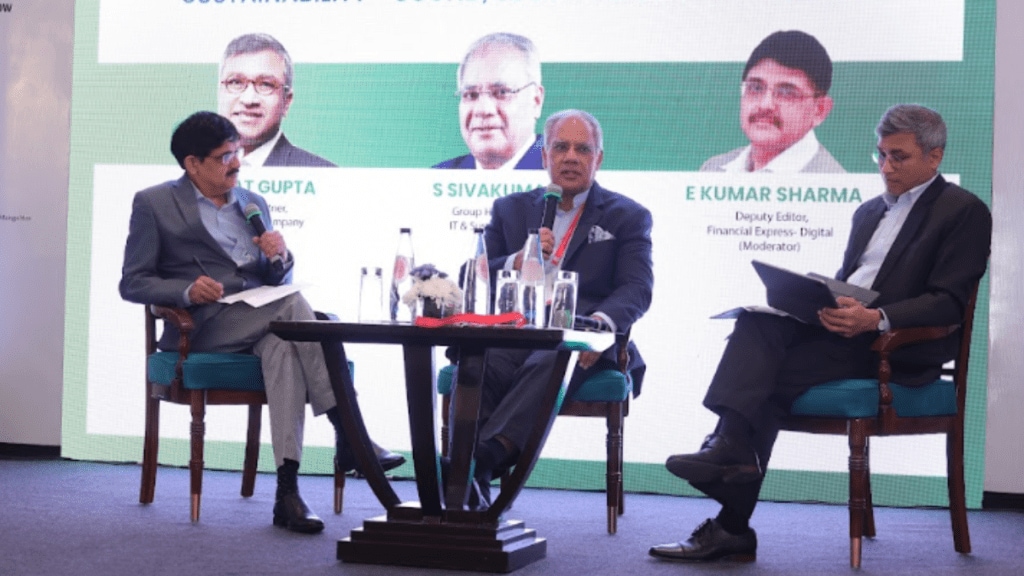In times when the ill-effects of extreme weather events are impacting lives and the curve on climate change is only getting steeper, ‘sustainability,’ has acquired a new urgency. After a year devoted to news coverage and reportage on the topic of sustainability under a specially created section ‘Green Sarathi,’ Financial Express Digital, opted to close the calendar year with a summit – The FE Green Sarathi Summit and Awards, 2024.
It saw a confluence of some of the finest minds and genuine practitioners and proponents of green practices. Sharing his insights at a fireside chat organised at the summit was S Sivakumar, who oversees ITC’s sustainability initiatives and social investment programmes apart from being the group head of ITC’s Agri and IT businesses.
On how to make efforts at sustainability truly fruitful and the extent to which these measures needed to be ‘built in’ rather than ‘bolted on’ a business model? Sivakumar sees little scope for choice. “The business of sustainability when you believe is the very sustainability of business then there is not much of a choice of building it in,” he says. Climate change, he says, “has already become a climate emergency” and taken with all the other elements would “impact the very sustainability of business.” Much like the unsustainability of building a factory to last for 40 years when there is no water in it likely after 10 years.
Underlining the need to think sustainability and work on it, he says, “this is something that we as a corporate have seen early on. The core part of every strategy,” he explains, “is seeing weak signals and amplifying them early on.”
Nearly three decades ago, ITC, he says, “articulated very clearly the various elements that are going to impact the future of society and therefore the business within that society.” For instance, it realised early on that if its paperboards business were to thrive, sustainable forests would be crucial and this led to a backward integration and plantations got the focus, they deserved. All of it, backed by suitable research and development.
Similarly, for the conglomerate’s agri plans to succeed and scale, focus was on farmer incomes and that contributed to its pioneering e-choupal initiative (which the company briefly describes as rural India’s largest internet-based intervention). “All of these needed to be an integral part of business and to make it happen, innovation had to be at the core of the business model and this,” he says, “has been our experience across the various business categories.”
But given the depth and width of actions required to combat climate change and the limits to activities and interventions that can be done within the fence of a company, Sivakumar says, “many of these things cannot be done by an individual enterprise and therefore how do you enable the larger eco-system to also operate,” is a question that apparently enterprises may need to constantly work on. This may entail working towards a suitable legislation or taking actions through an industry consortium. On these, basing on his experience, he says, individual industries can take on and have it enabled and once there is a proof of concept then it may help move in the direction of creation of a suitable digital public infrastructure.
But then, how is an impact assessment or measurement done before a business embarks on a sustainability project or venture? On this, Sivakumar points to “the common practice of double materiality of effort that is done as part of any sustainability effort. It is the impact our operations are going to have on the environment around and the society around and how we are going to get impacted by what is around. This is something that is done as a very elaborate exercise with a structured process of making all of this happen,” he explains.
On climate change that is today both a threat and an opportunity to act differently, he says, “over the last three years, one set of investments we are making is around generating new knowledge. For example, in agriculture, in the form of mapping the forecasts to implications to agriculture in different regions and building the toolkits to tweak the agronomy practices on a real time basis. A similar approach has been adopted for physical assets like factories and hotels. Now, we are using AI to locally optimise for different individual weather parameters.”
Elements such as these could ideally become part of a digital public infrastructure. Given the peculiarities of a large country like India with different regional priorities and the social licence needed to operate, Sivakumar feels, instead of only looking at the matrix as it is seen from an already developed economy perspective, we should also create “something that is developing country-centric or India-centric.” In India, for instance, “other the environmental aspects, social, from the perspective of inequality is very important.”


